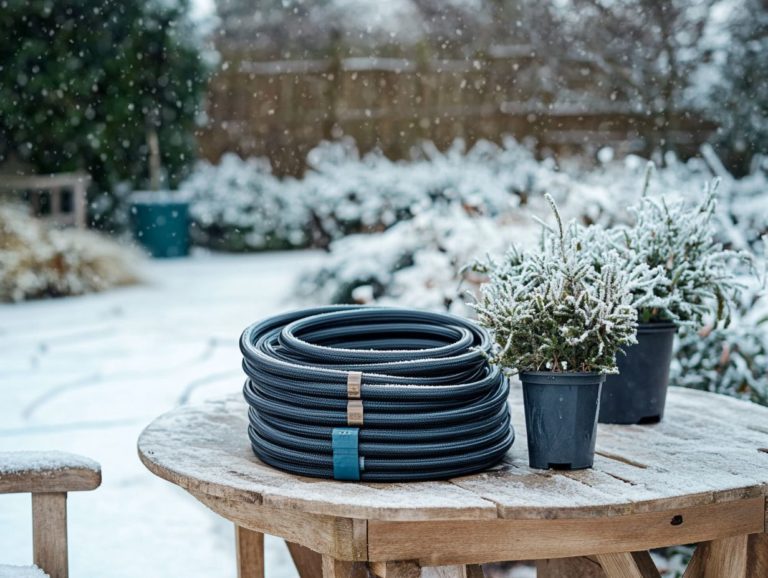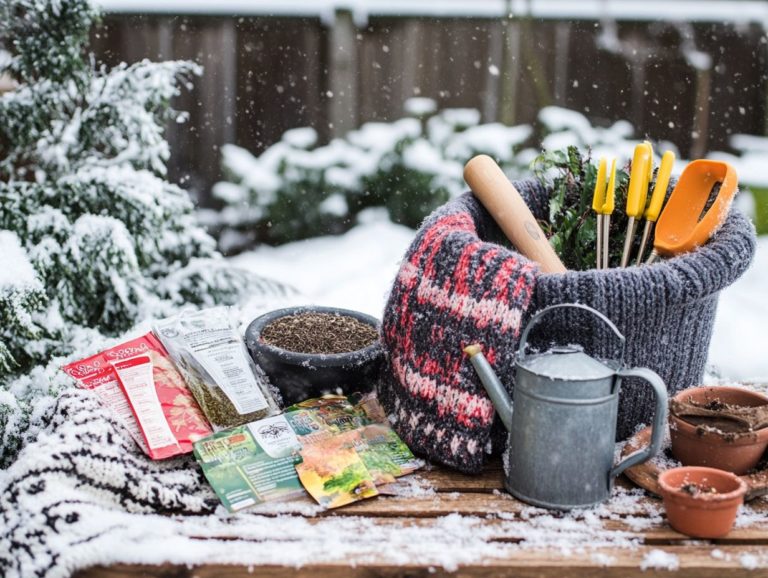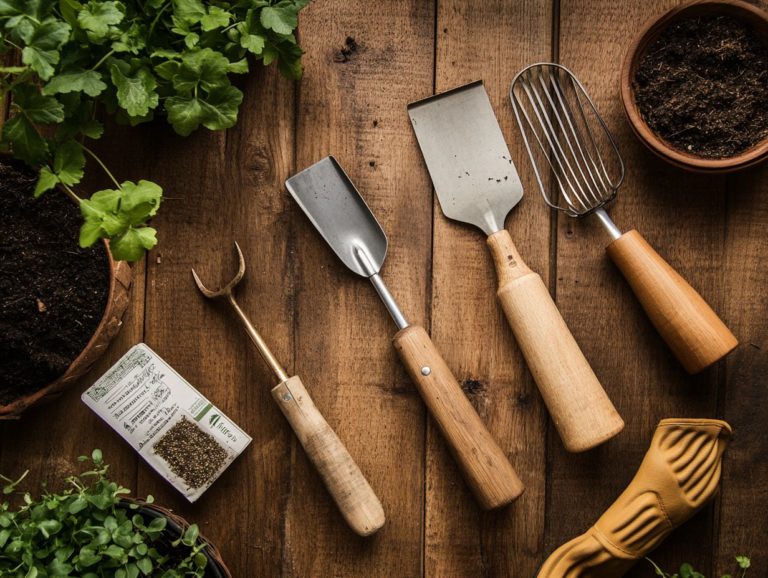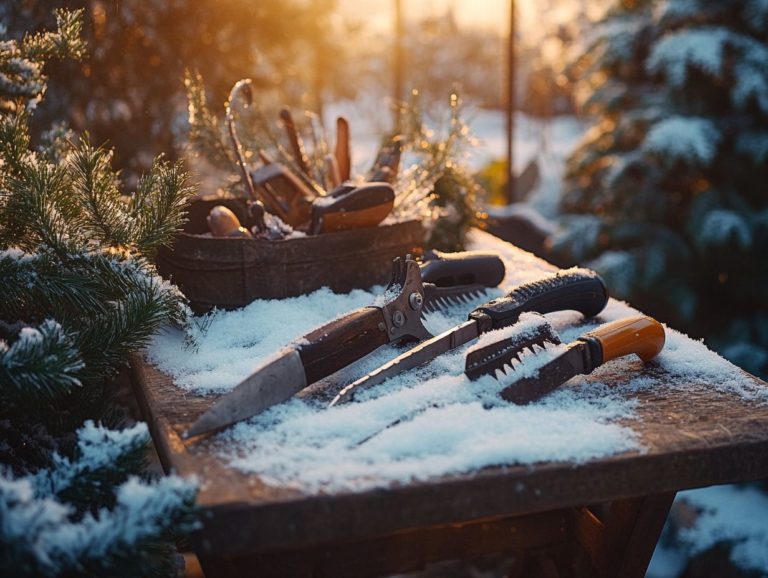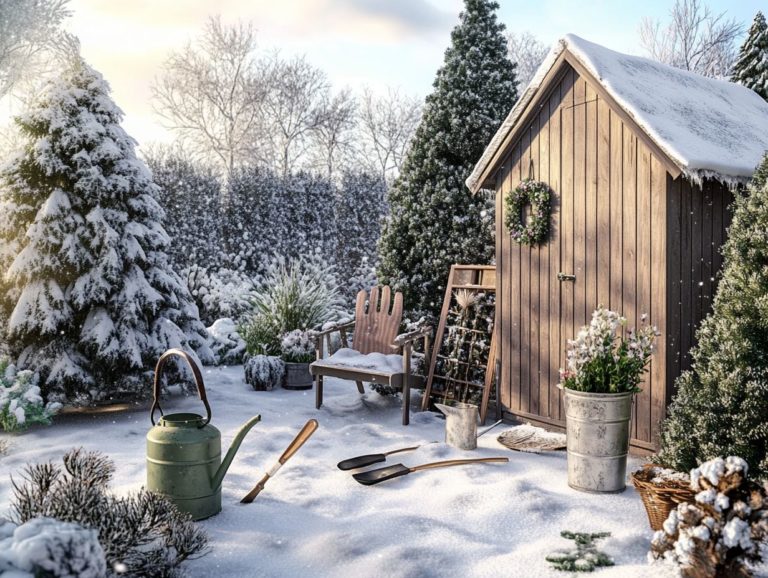How to Choose the Best Potting Mix for Cold Gardens
Choosing the right potting mix is essential for nurturing vibrant plants, especially in cold gardens where conditions can be challenging.
This guide explores how potting mix impacts plant growth and health. You ll learn about the best options tailored for cold gardens.
We also provide practical tips for application and maintenance to ensure your plants thrive.
Get ready to transform your gardening journey!
Contents
- Key Takeaways:
- The Importance of Choosing the Right Potting Mix
- Factors to Consider when Choosing a Potting Mix
- Understanding Cold Gardens
- Best Potting Mix Options for Cold Gardens
- Tips for Using Potting Mix in Cold Gardens
- Frequently Asked Questions
- What factors should I consider when choosing a potting mix for my cold garden?
- Does the type of container affect the choice of potting mix for a cold garden?
- Should I use a specialized potting mix for my cold garden?
- What are some common ingredients in a potting mix for cold gardens?
- Can I make my own potting mix for a cold garden?
- How often should I change the potting mix in my cold garden?
Key Takeaways:

- Choose a potting mix suitable for your climate and plant types to promote optimal growth.
- Consider the unique challenges of cold gardens, such as moisture retention and insulation.
- Proper application and maintenance can significantly enhance plant growth and protection.
The Importance of Choosing the Right Potting Mix
The right potting mix is crucial for your gardening success. It greatly affects plant growth and health.
A good mix ensures optimal moisture retention, aeration, and nutrient content for various plants, including vegetables and flowers.
The quality of commercial products can vary. It’s essential to make informed choices for the best results.
Understanding additives like coir and peat moss can boost soil performance and support healthy root growth. These beneficial soil fungi help plants absorb nutrients.
Factors to Consider when Choosing a Potting Mix
Carefully consider factors that influence plant health when choosing a potting mix. Climate and weather conditions will dictate the best option for your garden.
Different mixtures offer varying levels of moisture control and nutrient retention. For hot, dry climates, look for mixes with vermiculite and perlite for better aeration.
In colder regions, specialty blends with decomposed wood or charcoal can help retain warmth and optimize soil texture for healthy root development.
Climate and Weather Conditions
Climate and weather conditions are essential in determining the ideal potting soil or mix for your gardening endeavors, particularly in container gardening. By understanding the humidity levels, temperature fluctuations, and seasonal shifts in your local climate, you can select a potting mix that effectively retains moisture and promotes vibrant plant growth. Additionally, considering environmental concerns is crucial.
In arid regions with low humidity, choose potting soil that includes materials like coconut coir or perlite. These ingredients enhance moisture retention and promote healthy soil, ensuring your plants get the water they need.
On the other hand, in humid climates, selecting a mix with strong drainage properties such as one that contains expanded clay or tree bark helps prevent root rot and encourages airflow within the soil.
Selecting the right texture and composition, including a consideration for black soil, is vital. A sandy soil blend with larger particles thrives in warmer environments, while a finer mix enriched with organic matter and compost is better suited for cooler areas. These custom-tailored potting mixes not only adapt to your local climate but also dramatically improve plant performance, ensuring healthy seed starting and vibrant gardens throughout the year.
Types of Plants
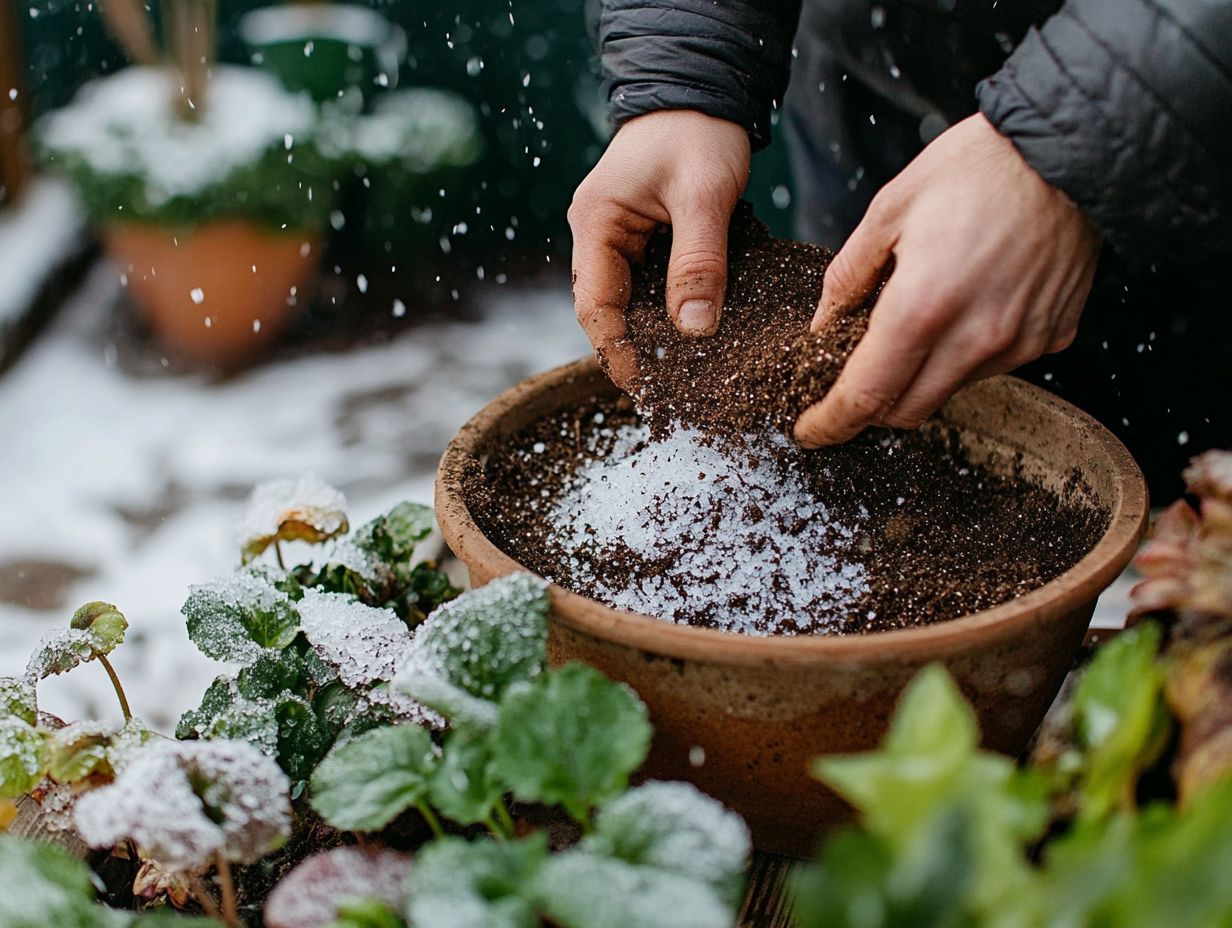
Different types of plants require tailored potting mixes and growing media to thrive. For instance, if you’re starting seeds indoors, a lighter potting mix with vermiculite and perlite can work wonders for encouraging germination, especially in hydroponic systems. When growing vegetables, including options like Mels Mix, you ll want a richer organic soil blend to support robust growth.
Knowing the specific nutrient needs is key to lush growth! Herbs often flourish in slightly drier conditions and might prefer a mix that includes more sand, grit, or earthworm castings to enhance drainage. Don’t forget to consider the specific nutrient requirements, including calcium and magnesium, of each type, as finding the right balance promotes healthy development and enhances the flavor in your culinary herbs.
Flowering plants typically thrive on potting mixes that retain moisture while allowing for air circulation. They benefit from the inclusion of peat moss and compost. Achieve this by selecting mixes that contain these organic soil components for optimal results. By choosing the right potting mixes tailored to their unique growing conditions, including specialty blends, you can cultivate a vibrant and healthy garden.
Understanding Cold Gardens
Cold gardens present distinct challenges for gardeners striving for vibrant plant growth, particularly when it comes to selecting the ideal potting mix or potting soil. To optimize your garden’s success, choosing the right location for a cold garden is essential. In these chilly environments, it’s crucial to choose potting soil that provides superior moisture retention, soil texture, and the right additives to support your plants’ health.
Integrating organic fertilizers, including commercial products and earthworm castings, as well as specialized blends can help counteract the negative effects of lower temperatures. This ensures your plants receive the nutrients they need throughout the growing season.
Characteristics and Challenges
Cold gardens pose unique challenges. They are marked by lower temperatures and fluctuating moisture levels that can stunt plant growth.
These conditions can slow root development and reduce nutrient uptake. It s crucial to choose potting mixes that excel in holding water and nutrients.
Maintaining consistent moisture is vital. Too much dryness can significantly impact plant vitality, highlighting the importance of a soil test.
The ideal potting mix should include components like coconut coir and perlite. Charcoal can also enhance aeration while retaining water.
Adding organic matter, such as compost and black soil, boosts nutrient content and helps maintain balanced soil structure.
Be selective about your potting mix. Tailor it to withstand the common stressors of colder climates by considering the top 10 soil amendments for cold-weather gardens to promote robust plant growth.
Best Potting Mix Options for Cold Gardens
When choosing a potting mix for cold gardens, prioritize options that excel in moisture control and provide necessary nutrients. For detailed guidance, check out how to select the right soil for cold gardens. Look for blends that include organic components like coir, peat moss, and earthworm castings.
These elements can greatly enhance your plants’ performance in cooler climates, ensuring both moisture retention and nutrient availability.
Features and Benefits of Each Type
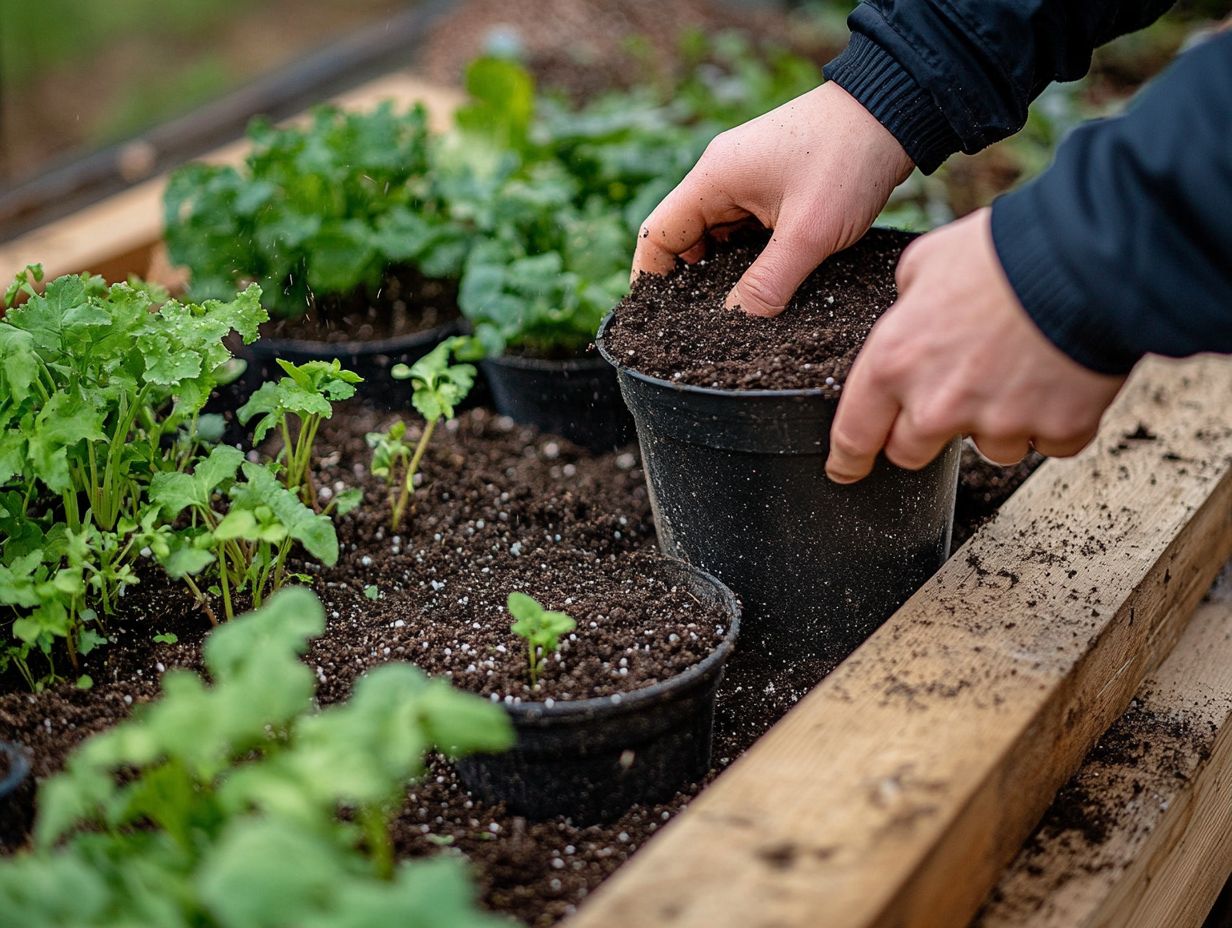
Different potting mixes offer unique features and benefits for cold gardens. For instance, mixes with organic components like perlite and compost improve moisture retention and aeration, which are essential for root health. To learn more about soil preparation for container gardening in cold climates, consider exploring various options that suit your needs.
These mixes often contain ingredients such as peat moss, which holds moisture and nutrients. This creates a reservoir that prevents your plants from drying out during frosty nights.
Perlite promotes excellent drainage, ensuring excess water doesn t harm root systems in cold, wet conditions. Compost delivers essential nutrients, cultivating a fertile environment for vigorous growth.
Choosing the right potting mix can craft a nurturing habitat that supports healthy plants all year round.
Tips for Using Potting Mix in Cold Gardens
To maximize the benefits of potting mix, focus on proper application and maintenance. These steps are crucial for healthy plant growth and optimal water movement.
Consider layering your potting soil with organic fertilizers, topsoil, and mulch. These practices enhance moisture retention and nutrient content, creating a stable environment for your plants.
Proper Application and Maintenance
The proper application of potting mix is essential in cold gardens, especially when selecting plants for cold climate community gardens. It ensures that your plants establish healthy roots and thrive throughout the growing season, particularly in raised beds.
Mixing in organic fertilizers, calcium, or layering with mulch can significantly enhance moisture retention and nutrient availability.
Incorporating well-decomposed compost and natural soil enriches your mix, promoting microbial activity (the activity of tiny living organisms in the soil), which is vital for plant health. When layering, alternate between rich organic matter, including organic fertilizers, and the potting mix to create a balanced environment.
Keep an eye on moisture levels to ensure your plants thrive! Adjust your watering schedule according to seasonal changes. Using protective covers during frosty nights shields your plants and reduces moisture loss. This allows your potting mix to maintain its integrity and support robust growth in chilly conditions.
Frequently Asked Questions
What factors should I consider when choosing a potting mix for my cold garden?

When choosing a potting mix for a cold garden, consider your climate, drainage, and nutrient content of the mix. For detailed guidance on selecting the best option, check out how to choose the right soil for winter gardening. Cold temperatures can affect plant growth, so a mix with good drainage and high nutrient levels promotes healthy growth.
Does the type of container affect the choice of potting mix for a cold garden?
Yes, the type of container influences your choice. For example, clay pots lose heat more quickly than plastic pots, so a mix with better insulation may be needed for plants in clay pots in cold climates.
Should I use a specialized potting mix for my cold garden?
Using a specialized potting mix designed for cold gardens is recommended. For more information, check out what is the best soil for cold-climate gardens. These mixes often contain ingredients that help retain heat and provide the necessary nutrients for plants to thrive in colder climates.
What are some common ingredients in a potting mix for cold gardens?
- Peat moss
- Perlite
- Vermiculite
- Compost
These ingredients help improve soil structure, drainage, and nutrient levels to support plant growth in colder temperatures.
Can I make my own potting mix for a cold garden?
Yes, you can make your own potting mix using a combination of organic materials such as compost, peat moss, and vermiculite. To optimize your cold gardens, consider learning how to use compost in cold-weather gardening by researching and following a recipe that includes ingredients with good insulation and nutrient-rich properties.
How often should I change the potting mix in my cold garden?
The frequency of changing the potting mix depends on various factors such as the type of plants, the size of the container, and the quality of the potting mix. Generally, it s recommended to change the potting mix every 1-2 years to ensure the best growing conditions for your plants.
Try these tips today for a flourishing cold garden!

